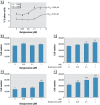Parabens and Human Epidermal Growth Factor Receptor Ligand Cross-Talk in Breast Cancer Cells
- PMID: 26502914
- PMCID: PMC4858398
- DOI: 10.1289/ehp.1409200
Parabens and Human Epidermal Growth Factor Receptor Ligand Cross-Talk in Breast Cancer Cells
Abstract
Background: Xenoestrogens are synthetic compounds that mimic endogenous estrogens by binding to and activating estrogen receptors. Exposure to estrogens and to some xenoestrogens has been associated with cell proliferation and an increased risk of breast cancer. Despite evidence of estrogenicity, parabens are among the most widely used xenoestrogens in cosmetics and personal-care products and are generally considered safe. However, previous cell-based studies with parabens do not take into account the signaling cross-talk between estrogen receptor α (ERα) and the human epidermal growth factor receptor (HER) family.
Objectives: We investigated the hypothesis that the potency of parabens can be increased with HER ligands, such as heregulin (HRG).
Methods: The effects of HER ligands on paraben activation of c-Myc expression and cell proliferation were determined by real-time polymerase chain reaction, Western blots, flow cytometry, and chromatin immunoprecipitation assays in ERα- and HER2-positive human BT-474 breast cancer cells.
Results: Butylparaben (BP) and HRG produced a synergistic increase in c-Myc mRNA and protein levels in BT-474 cells. Estrogen receptor antagonists blocked the synergistic increase in c-Myc protein levels. The combination of BP and HRG also stimulated proliferation of BT-474 cells compared with the effects of BP alone. HRG decreased the dose required for BP-mediated stimulation of c-Myc mRNA expression and cell proliferation. HRG caused the phosphorylation of serine 167 in ERα. BP and HRG produced a synergistic increase in ERα recruitment to the c-Myc gene.
Conclusion: Our results show that HER ligands enhanced the potency of BP to stimulate oncogene expression and breast cancer cell proliferation in vitro via ERα, suggesting that parabens might be active at exposure levels not previously considered toxicologically relevant from studies testing their effects in isolation.
Citation: Pan S, Yuan C, Tagmount A, Rudel RA, Ackerman JM, Yaswen P, Vulpe CD, Leitman DC. 2016. Parabens and human epidermal growth factor receptor ligand cross-talk in breast cancer cells. Environ Health Perspect 124:563-569; http://dx.doi.org/10.1289/ehp.1409200.
Conflict of interest statement
The authors declare they have no actual or potential competing financial interests.
Figures





References
-
- Anisimov VN, Popovich IG, Alimova IN, Zabezhinski MA, Semenchenko AV, Yashin AI. Number of pregnancies and ovariectomy modify mammary carcinoma development in transgenic HER-2/neu female mice. Cancer Lett. 2003;193:49–55. - PubMed
-
- Barr L, Metaxas G, Harbach CA, Savoy LA, Darbre PD. Measurement of paraben concentrations in human breast tissue at serial locations across the breast from axilla to sternum. J Appl Toxicol. 2012;32:219–232. - PubMed
-
- Barros FF, Powe DG, Ellis IO, Green AR. Understanding the HER family in breast cancer: interaction with ligands, dimerization and treatments. Histopathology. 2010;56:560–572. - PubMed
MeSH terms
Substances
LinkOut - more resources
Full Text Sources
Other Literature Sources
Research Materials
Miscellaneous

